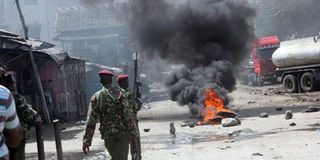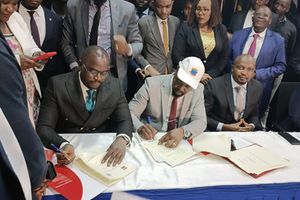Riots hit Mombasa after cleric shot dead

Police react at the scene of angry protests in King'orani area that left four people dead and seven others injured October 4, 2013. Calm returned to Mombasa October 5, 2013. LABAN WALLOGA
What you need to know:
- Sheikh Umar and his colleagues were shot dead near the spot where his predecessor, Sheikh Aboud Rogo, was slain last year.
Four people were killed and eight others injured in sporadic violence that swept through parts of Mombasa County Friday as youths engaged police in running battles to protest against the killing of a Muslim preacher on Thursday night.
The chaos started outside Musa Mosque in Majengo several hours after its fiery preacher, Sheikh Ibrahim Umar alias Rogo, was killed together with three other people shortly after giving lectures at the mosque. A fourth person survived after pretending to be dead.
Protesting youths yesterday set ablaze the Salvation Army Worship Centre which is about 200 metres from the Musa Mosque.
However, fire engines from Mombasa Fire Brigade contained the blaze which had consumed a section of the centre. Police arrested 24 youths in Majengo. They were believed to be among those behind the arson.
Sheikh Umar and his colleagues were shot dead near the spot where his predecessor, Sheikh Aboud Rogo, was slain last year.
Rogo was an alleged recruiter for Al-Shabaab, the Islamist militants who operate from Somalia and who last month claimed responsibility for the terrorist attack in which 67 were killed at Westlands’ Westgate shopping mall, Nairobi.
Friday, public transport was brought to a halt in parts of Mombasa as the youths, who accused anti-terrorism police of being behind the killing of the cleric, unleashed violence on innocent civilians.
Many streets were deserted in the wake of the violence. Matatus and other public transport vehicles as well as private cars were withdrawn from the roads, leaving Mombasa a ghost city. Shops, supermarkets and businesses in the central business district were also closed.
A Kenya Red Cross Society official said seven people were being treated at Coast General Hospital for injuries sustained during the riot.
“Two died in the chaos and two others succumbed in hospital,” said Mr Michael Abei, the agency’s Coast regional disaster officer. “One of the eight injured was treated by our paramedic team at the scene and released. Two others were taken to Jocham Hospital before being transferred to the Coast General Hospital.”
A hospital official, who spoke to the Saturday Nation on condition of anonymity, said two of the dead had gunshot wounds. The bodies were collected by their families for burial.
Mombasa OCPD Kipmoi Rop led a contingent of GSU, regular and Administration Police officers in controlling the rowdy youths, who had lit tyres to block several roads in Majengo and King’orani areas.
Riots spread within Mombasa Island with one group of youths smashing windows and forcing businesses to close in the General Post Office area. Police battled the stone-throwing youths who were shouting religious slogans.
Sheikh Ibrahim was killed together with Gaddafi Mohamed, a carpenter, Issa Abdalla (Gaddafi’s brother-in-law) and Omar Abu Rumeisa. Mr Salim Aboud, who was with them, survived by feigning death.
Learning in many schools was paralysed in the afternoon. Among those that were closed were Sacred Heart Primary, Mvita Primary, Abu Hureira Academy, PCEA and Makupa Primary, all on the main island.
Some school buses which were dropping kindergarten and lower primary pupils at around midday were diverted after word went round that some roads had been blocked by the protesting youth.
St Augustine Primary School headteacher Sarah Kessi said some of the buses were diverted to their compound.
“I had three Fly Mart School buses which carry students from different schools in my compound and they only left after police assured us the roads were secure. Other buses were from Loreto and Ganjoni primary,” she said.
Learning at St Augustine was also stopped by mid-morning and parents called to pick their children to ensure their safety.
At Ganjoni Primary, headteacher Wilfrida Odongo said learning continued amid tight security. She, however, said the school did not allow pupils to leave the compound during the lunch break as is the norm.
“We cannot afford to risk the lives of children in the streets at this time. Learning has continued. However, parents who wanted to pick up their children were allowed to do so.”
Sparki Primary School headteacher Alfred Nthiga said worried parents flocked the school to collect their children when the chaos started.
Additional reporting by Rebecca Okwany Twitter:@beckyakinyi
[email protected]





